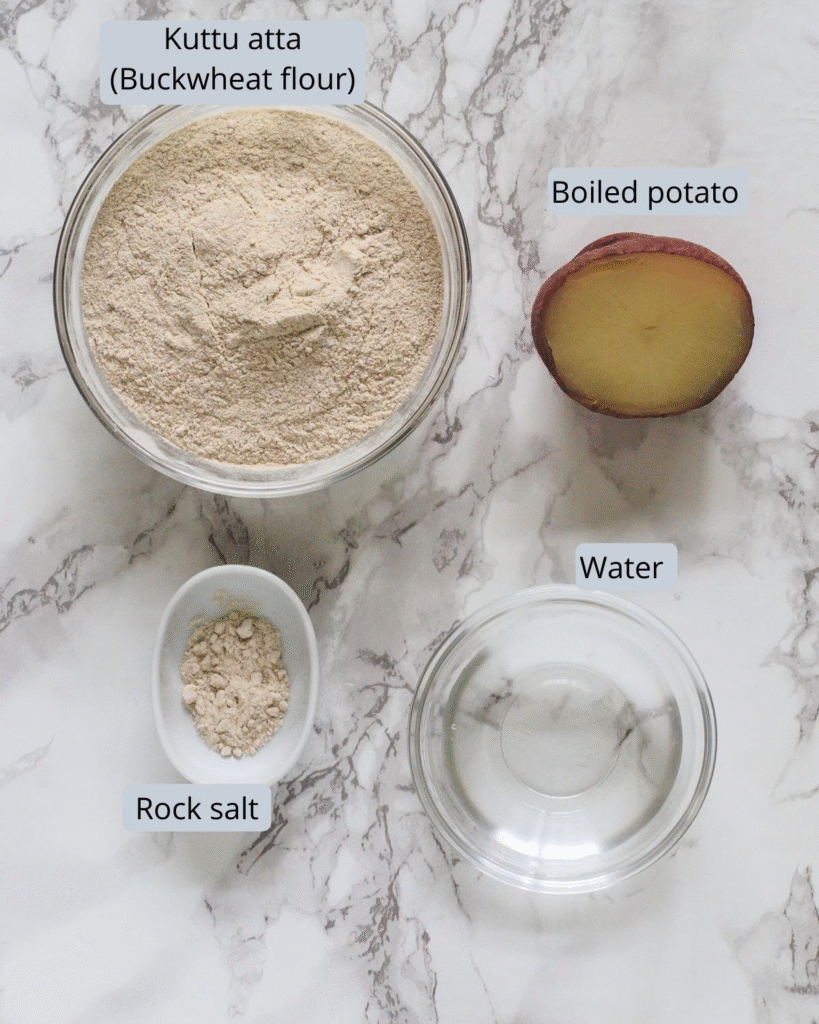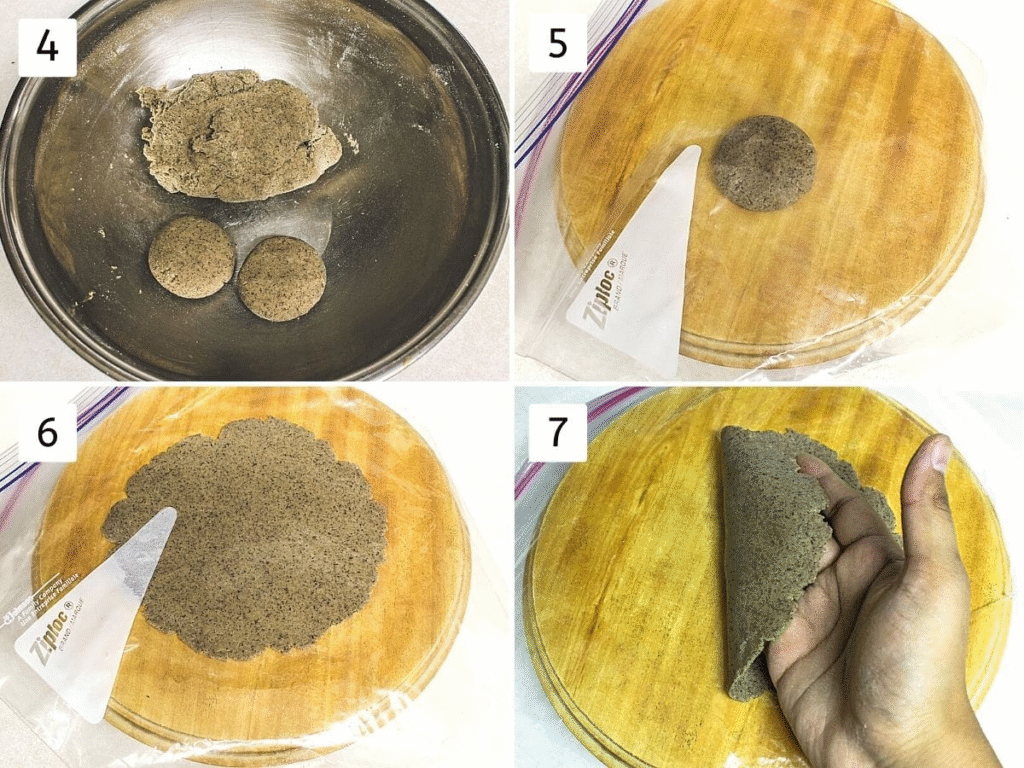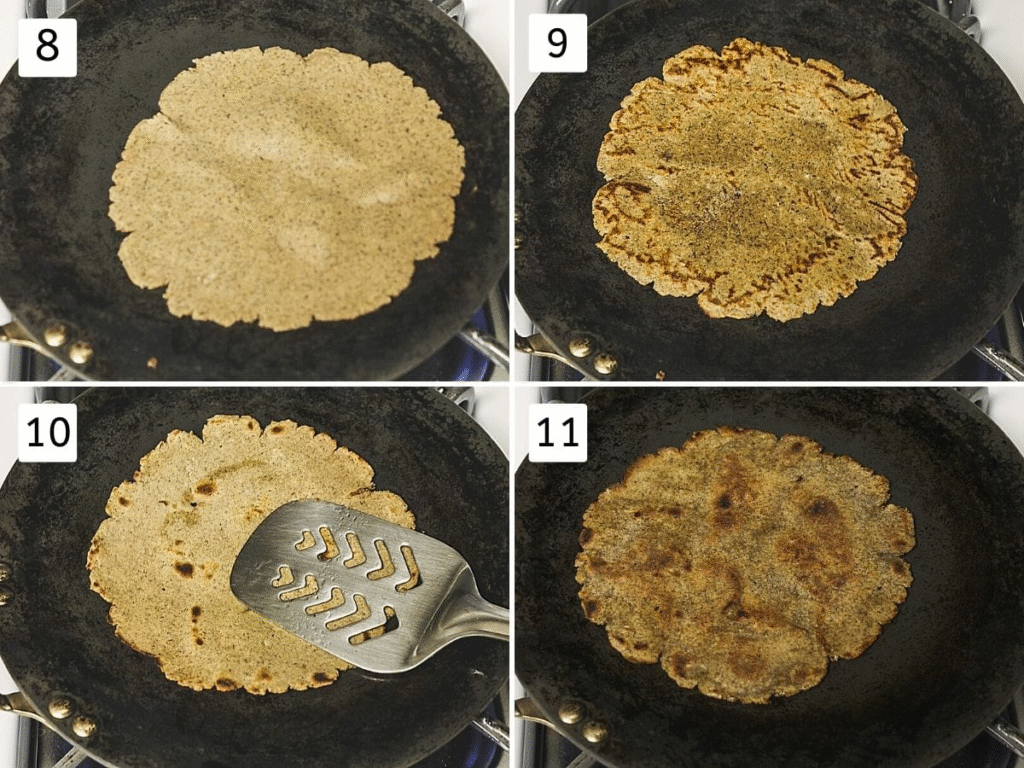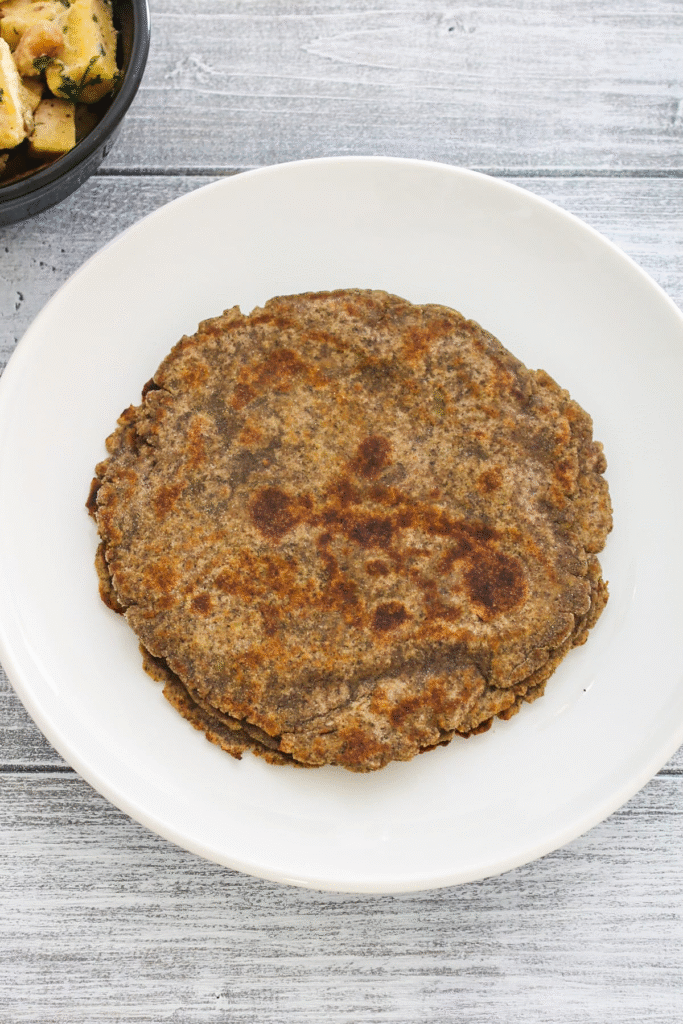This wholesome and flavorful Kuttu Paratha —also known as buckwheat flatbread—is a popular dish traditionally prepared during Hindu fasting days such as Navratri, Ekadashi, Janmashtami, and Maha Shivratri. It holds a special place in vrat (fasting) meals due to its simplicity, sattvic nature, and nourishing qualities.
Made using kuttu ka atta (buckwheat flour), this paratha boasts a delightful nutty aroma and earthy flavor. Buckwheat, though commonly mistaken for a grain, is actually a pseudo-cereal and entirely gluten-free. Since it doesn’t fall under the category of true grains, it’s widely accepted in Hindu fasting (vrat) diets. Its grain-free nature makes it an ideal choice for religious fasts like Navratri, Ekadashi, Janmashtami, and Maha Shivratri. One of its standout qualities is that it’s naturally gluten-free, which makes it an excellent option for those with gluten sensitivities or celiac disease. Additionally, it’s 100% vegan, containing no animal products, making it ideal for a plant-based lifestyle.
. The parathas are typically made by combining kuttu flour with boiled potatoes or arbi (colocasia), which help in binding the dough since the flour lacks gluten. When pan-fried in ghee or oil, these parathas turn wonderfully crisp on the outside while remaining soft and satisfying on the inside.
Whether served with a bowl of cooling yogurt, vrat-special aloo sabzi, or a dollop of homemade white butter, this dish is both comforting and deeply rooted in traditional fasting customs. It’s a perfect example of how fasting food can be both nutritious and delicious, offering a balance of taste and health in every bite.

❤️ About This Kuttu Paratha Recipe
The color of kuttu paratha can vary significantly depending on the type and brand of buckwheat flour (kuttu atta) being used. Some flours are finely milled and lighter in shade, while others are more coarsely ground, giving the paratha a darker, more rustic appearance. This variation is completely natural and depends on factors such as the region where the buckwheat is grown and the level of processing the flour undergoes. So don’t be surprised if your kuttu paratha looks different each time you use a new batch of flour.
Kuttu atta, or buckwheat flour, is considered thermogenic in nature, meaning it naturally generates warmth within the body upon consumption. This warming quality makes it especially suitable for colder seasons or fasting days when the body may need extra energy and heat.. Because of this, it is traditionally balanced with cooling foods during fasting rituals, especially yogurt or curd-based accompaniments like dahi aloo, raita, or plain curd sprinkled with roasted cumin powder. This not only enhances the flavor but also maintains the body’s internal balance during vrat (fasting) days.
Although kuttu flour is traditionally reserved for Hindu fasting festivals like Navratri, Ekadashi, Maha Shivratri, and Janmashtami, it is much more than just a fasting food. As a nutrient-rich pseudo-grain, kuttu can easily be incorporated into your everyday meals, offering a wholesome dose of protein, fiber, and essential minerals like magnesium and iron—making it a smart choice for balanced, gluten-free nutrition year-round.
It is naturally gluten-free and contains a substantial amount of dietary fiber, which supports healthy digestion and gut function. Moreover, it is rich in essential minerals like magnesium, phosphorus, iron, and zinc, and it also provides a decent amount of plant-based protein, making it suitable for those on a vegetarian or vegan diet.
Including kuttu paratha occasionally—even outside fasting periods—can be a wholesome addition to a balanced diet. Its nutty flavor, combined with its health benefits, makes it a versatile and nourishing food option for anyone looking to explore ancient grains and pseudo-cereals in their meals.
🧾 Ingredient Notes
Here’s a snapshot of the simple yet essential ingredients used in preparing kuttu paratha. This wholesome recipe calls for just a handful of ingredients, making it both fuss-free and ideal for fasting days.

- Potatoes: Boiled and mashed potatoes play a crucial role in this gluten-free (GF) dough preparation. Since buckwheat flour lacks gluten, the addition of potatoes helps bind the flour, making the dough soft, pliable, and much easier to roll without cracking. Their natural starch content also gives the paratha a nice texture. For a subtle twist in taste and added nutrition, I sometimes combine mashed potatoes with sweet potatoes. The sweet potato adds a mild sweetness and creaminess that beautifully complements the earthy notes of buckwheat flour.
- Rock Salt (Sendha Namak): Widely regarded as pure and sattvic, sendha namak holds a special place in Hindu fasting traditions. It is the salt of choice during vrat (fasting) days, as it aligns with spiritual and dietary guidelines. Unlike common iodized table salt—which is generally avoided during fasts—sendha namak is naturally sourced and unprocessed, making it acceptable for religious observances.
- Ghee or Oil (Not Shown in the Picture): While not visible in the image, cooking the paratha requires a small amount of fat. You can use either ghee for a rich, aromatic flavor or peanut oil for a slightly nutty taste. Both are suitable for vrat and enhance the overall taste and crispness of the paratha when pan-fried. Ghee, in particular, adds a traditional touch and boosts satiety, making it ideal for fasting days.
👩🍳 How To Make Kuttu Paratha? (Pics)
1) Combine Ingredients: In a mixing bowl, add the kuttu (buckwheat) flour along with sendha namak (rock salt), which is commonly used during fasting. Next, add the mashed potatoes, which act as a natural binder and help in shaping the dough easily.
2) Blend the Mixture: Using your fingertips, gently mix everything together. The warmth of your hands helps integrate the mashed potatoes into the flour, forming a crumbly texture that starts to hold together.
3) Form the Dough: Begin adding water gradually, a little at a time, while kneading. You’ll notice the dough coming together quite quickly without much effort. It doesn’t require any resting time, so you can proceed immediately to the next step.

4) Shape into Portions: Divide the smooth and pliable dough into 8 equal parts. Gently shape each portion into a smooth, round ball by rolling it between your palms with light pressure. Lightly flatten each ball to form thick discs, which will make it easier to roll them out later.
5) Prepare for Rolling: Take a clean ziplock bag and cut open its sides to create two flat plastic sheets.Position one of the flattened dough portions gently between the two layers of the opened ziplock bag or parchment sheets. This prevents sticking and makes it easier to roll the dough into a round shape without breaking or tearing.
6) Take one of the flattened dough balls and start rolling it out gently using a rolling pin. Aim for a circular shape approximately 5 to 6 inches in diameter. Since the dough is delicate due to the absence of gluten, avoid applying too much pressure—use light, even strokes to prevent it from tearing or sticking. While you’re rolling out the dough, place a tawa (griddle) on the stovetop and begin heating it over medium flame so it’s ready by the time the paratha is rolled.
7) Once rolled, carefully lift the paratha. It’s best to do this slowly and gently, using your hands or a flat spatula, to ensure it doesn’t break or lose its shape. If you’re using a ziplock sheet or parchment paper to roll it, you can lift it along with the sheet and then invert it onto your palm or directly onto the hot tawa.

8) Place the rolled paratha on the preheated tawa. Let it cook on one side for a few seconds without moving it, just until you notice slight changes in color and the surface starts to look a bit drier.
9) When light brown spots or specks begin to appear on the underside, flip the paratha carefully using a spatula. Let the bottom side cook for about 30–40 seconds or until you notice light golden spots forming. After that, drizzle a bit of ghee or oil along the edges and gently spread a small amount over the top to boost the flavor and give the paratha a crisp, aromatic finish.
10) Flip it again and gently press along the edges using a spatula to ensure uniform cooking and help the paratha puff up slightly for a soft yet crisp texture.. This helps ensure the paratha cooks through and gets those lovely air pockets. Apply a little more ghee or oil on this side as well to enhance the flavor and get that lovely golden crisp texture.
11) Flip one final time and continue pressing and cooking until both sides have light brown, crispy patches, and there are no raw or doughy spots left. The paratha should be soft yet crisp in places.Carefully place the cooked paratha on a plate. Continue the same method with the rest of the dough portions. Serve them hot with yogurt, a fasting-approved chutney, or spiced potato curry for a wholesome and satisfying vrat meal

🥣 Storage Instructions
- On fasting days (vrat or upvas), pair this kuttu paratha with vrat-friendly dishes like dahi arbi, suran ki sabzi, dahi wale aloo, or rajgira kadhi for a wholesome meal.
- For best taste and balance, enjoy this paratha with a cooling, yogurt-based accompaniment—it complements the warming nature of kuttu perfectly.

